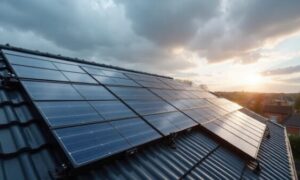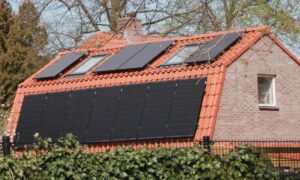Do you have an unoccupied rooftop that receives unlimited sun? Have you thought of making it a source of electricity? From rural to urban, you will find countless houses with empty rooftops, which are brilliant spaces for producing power.
People are installing rooftop solar panels as non-renewable electricity production becomes more expensive. These eco-friendly and sustainable solutions make best friends during blackouts and help lower greenhouse effects. So, if you plan to go solar, here is everything you need to know.
What Is A Solar Rooftop?
Residential, commercial, industrial, or institutional buildings have multiple solar panels installed on their roofs. These are known as solar rooftops or solar rooftop systems. With the sun’s energy that they receive, the system generates electrical power. You can also refer to it as the solar rooftop PV or photovoltaic system.
The energy it generates is green and ecological and does not emit baleful gases or pollutants. The global solar market aims to make Mother Earth healthier and safer. For the best outcome, solar rooftop panels take up enough space and require adequate exposure to the sun.
Most think that working with solar power is tricky. However, all you will need is a usable rooftop. When you install a solar rooftop, the photons from the sunlight will fall on it and convert to DC electricity electrons. Hence, residents can easily convert enough energy from the sun into electricity to fulfil their household requirements.
The inverters of rooftop solar systems also convert the DC (direct current) into AC (alternating current), which several household appliances use. These include TVs, computers, washing machines, etc. The solar rooftop price is reasonable if you buy from a reputable company.
Rooftop Solar System Types
Rooftop solar systems come in different types. These are as follows:
- Off-Grid: These are power systems that work independently of the grid. Their design allows them to operate well only with a diesel generator or a battery backup for remote uses.
- Grid-Tied: To aid the electrical load in case the power goes out, it runs effectively with a diesel generator or a battery backup.
- Grid-Interactive: The job of such rooftop solar systems is to mainly send back the grid the produced power while you use the electricity the grid provides for household needs. When there is a blackout, the inverter halts the system from working to prevent the grid from receiving power. Thus, helping stop utility workers from being electrocuted.
Working Of Solar Rooftop Panels?
For producing electricity, rooftop solar panels wield the sun’s energy. In case you are wondering how they comprise integrated solar cells. These are tiny semiconductors, square in shape, and made from silicon and other conductive materials.
When these solar cells receive sunlight, a chemical reaction takes place, which causes the electrons to release. As a result, it produces a direct electric current. Rooftop solar system panels usually have PV cells, which are an essential component. These cells are of three types:
- Single Crystal: This is an expensive PV cell type as this solar cell works at higher power. If you install single crystal PV cell modules, it can boost your house’s efficiency.
- Polycrystalline: These cells have around 15% lower efficiency than a single crystal, but the manufacturing cost of this type of solar rooftop is also lower. The small size offers closely packed cells which help raise the total energy generated.
- Amorphous Silicon: The production of these types of PV cells is the cheapest because their making involves a thin film application of silicon on a metal or glass material. Nonetheless, they offer less efficiency.
Different Components of A Solar Rooftop System
The composition of a solar energy rooftop system comprises four main components. These include a solar panel, solar battery, solar inverter, and a mounting stand for the module.
- Solar Panel: No system will be complete without solar panels. These are what you see on rooftops with a solar power system. Their shape resembles a board and helps produce electricity by capturing the sun’s energy.
- Solar Battery: All the power produced from converting solar energy gets stored in the solar battery. When the grid stops operating, this power comes into use.
- Solar Inverter: It is a valuable electrical device that helps convert DC electricity from solar panels to AC electricity.
- Mounting Stand: It is a metal structure to ensure the panels stay in place and maintain an angle to receive the sun.
How Are Rooftop Solar Panels Beneficial?
Over the years, there has been a rise in the popularity of solar rooftops. Several households are slowly going green and looking forward to installing solar power solutions. If you are wondering how you can benefit from a solar rooftop, here is a list of its benefits:
Reduction in Expenses
You can slim down your expenses by installing a solar rooftop system for your house. It is because the tariff rates for rooftop solar are lower than that of commercial or industrial. As a property owner, you can save on electricity costs by installing these power systems. However, you just need to find reliable company to get the best solar rooftop price for your home.
Electricity Source
Certain parts of India, urban and rural, struggle to receive adequate and dependable electricity supply. As a result, residents use hazardous and non-eco-friendly alternatives like diesel generators that can harm their health. As a result, solar energy is far more dependable and lighter on your pockets. Also, it has no fluctuating operating expenses.
Easy To Maintain
Another significant advantage of these systems is that they do not require regular maintenance. If you keep them in decent condition, they can last you for over 20 years.
Lowers Greenhouse Emissions
Solar panels are nothing like non-renewable electricity generation methods. Instead, they help convert the sun’s energy to produce electrons. As a result, it helps decrease the emission of greenhouse gases. Unlike generators, they make no noise and release much less hazardous gases. It is also an appreciable step for dealing with climate change.
Conclusion
Utility prices are constantly increasing while the condition of our environment is going down. For this, a cleaner and more sustainable option is solar rooftops. These include a collection of solar panels that occupy the space on the roof of a building to generate solar power.
It is an effective system that helps save money and is more accessible and easy to maintain. You can fulfil your household needs with little investment and no pollution.



































